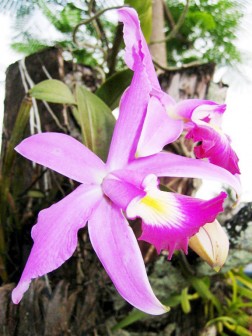The Cattleya Orchid (Cattleya spp.) occurs naturally throughout Central and South America and belongs to the largest plant family in the world, Orchidaceae. The Cattleya genus is considered by many to embody the romanticised appearance of an orchid, and is commonly referred to as the ‘Queen of Orchids.’
The flowers born by the ‘Queen of the Orchids’ are some of the most lustrous flowers in the world, with large petals and frilly lips (labellum). The colours of the blossom can vary from lavender to deep reds, and whites, and vary in size and shapes. These orchids are epiphytes and have well-developed water storage organs called pseudobulbs and large fleshy roots. The plants are long-lived perennials and will usually flower annually but will take up to three to four years before their first blossom, and the showy flowers can last up to a month.
Though the Orchid is named after the British naturalist, William Cattleya, it was another plant collector William Swainson who first brought the Cattleya from the depths of the Amazon Forest in Brazil to the West in 1817. However, because Swainson never documented and shared the exact location where he made the first collection of Cattleya, a 71-year search by other plant collectors ensued before these beautiful orchids were rediscovered to great fanfare in the horticulturist world.
![]() In Guyana, encounters with Cattleya orchids would be of the lavender or purple variety (Cattleya labia); if you look carefully, their large, round leathery leaves can be found clinging to the branches or trunks of trees along rivers and creeks at a height of about 20-30 feet. About a month before the rainy season, the flamboyant lavender flowers are easy to spot.
In Guyana, encounters with Cattleya orchids would be of the lavender or purple variety (Cattleya labia); if you look carefully, their large, round leathery leaves can be found clinging to the branches or trunks of trees along rivers and creeks at a height of about 20-30 feet. About a month before the rainy season, the flamboyant lavender flowers are easy to spot.

Around the world the most popular of the Cattleya orchids are manmade hybrids derived from combining these species with some of their close relatives.
The popularity of Cattleyas in horticulture is due to their relative ease to cultivate and high success in hybridization.
To help protect wild populations of orchids, and ensure the international orchid trade is not detrimental to the survival of many species, the entire orchid family is listed as in need of protection, with some species classified as endangered by the Convention on International Trade in Endangered Species (CITES).
Rain forests are rich in biodiversity and are home to many different plants and animals. In addition, indigenous communities make their homes there. Even if you don’t live in the rain forest, humans rely on the forest for resources such as building materials (wood and lianas), medicine and fruits. Rain forests also provide essential environmental services for life on earth; they create soil as well as prevent soil erosion, produce oxygen though photosynthesis, maintain clean water systems, and are a key defence against climate change.
The Iwokrama Rain Forest is 371,000 hectares, located in the heart of Guyana. Our mission is to develop strategies for conservation and sustainable development for local people in Guyana and the world at large. We are involved in tourism, training, research and our timber is certified by the Forest Stewardship Council. Come and visit us in the rain forest or at http://www.iwokrama.org.










